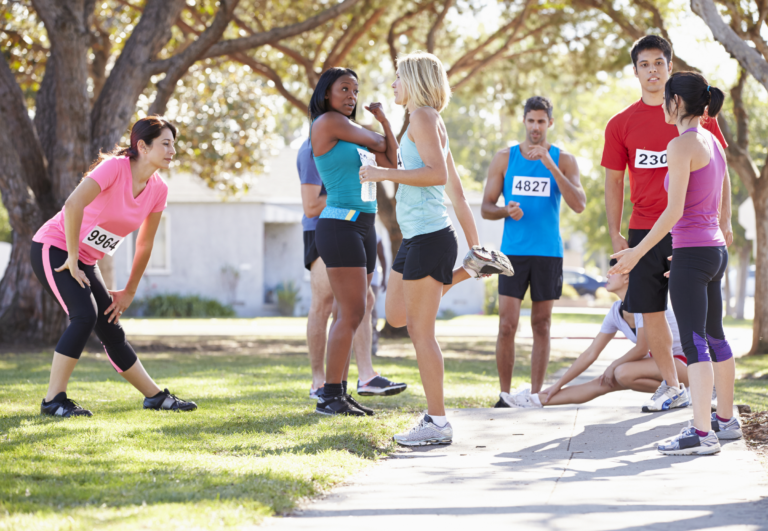Psychological Benefits of a Pre-Run Warm-Up: Enhancing Mental Preparedness for Runners
Embarking on a run without a proper warm-up can be like setting off on a road trip without checking your vehicle; you may reach your destination, but the journey might be less efficient and enjoyable.
A pre-run warm-up prepares not only your body but also your mind for the miles ahead. As you engage in dynamic stretches and light jogging, you’re not just loosening muscles and increasing heart rate – you’re also cultivating a focused and confident mindset that can influence your entire run.

As an experienced runner, I’ve found that integrating a thoughtful warm-up routine can significantly enhance running performance. The psychological benefits are just as vital as the physical ones.
Starting with positive self-talk and visualization exercises during your warm-up can lay a strong foundation for self-assurance and a sense of control. This boost in confidence can help you navigate the physical challenges of running more effectively, proving that the mind-body connection is powerful in the world of athletics.
Psychological Benefits of the Pre-Run Warm Up for Runners

Engaging in a proper warm-up is a pivotal step in your running routine, enhancing not only your physical readiness but also giving you psychological edge.
Enhancing Muscle and Joint Functionality
Your warm-up routine, through exercises like dynamic stretching and jogging, prepares your muscles and joints for the run ahead. This preparation can reduce the chance of muscle soreness and improve your range of motion. By elevating your body temperature, your muscles perform more efficiently, which can instill a sense of readiness and confidence in your capabilities.
Activating the Cardiovascular System
As you start walking or perform a light jog on the treadmill, your heart rate begins to rise. The gradual increase in breathing rate and blood flow ensures that your body is sufficiently oxygenated. This process helps in mentally gearing up for the impending physical exertion, allowing you to feel more in control and prepared for the running performance.
Priming the Nervous System for Performance
A comprehensive warm-up engages your brain and nerves, enhancing coordination and neural pathways essential for running performance. As the warm-up progresses, your mental focus sharpens, setting up a mind-muscle connection that can lead to improved technique and efficiency in your stride.
Warm-Up Techniques and Exercises
Before you hit the road, it’s vital to prime your muscles and joints with targeted warm-up techniques and exercises. These routines not only aid in preventing injuries but also enhance your running performance. Let’s explore the components your pre-run warm-up should include.
Dynamic Stretching Essentials
Dynamic stretching plays a crucial role in preparing your body for a run by enhancing mobility and activating key muscle groups like your hips, hamstrings, and quads. Start with leg swings to kick-off circulation, followed by high knees to engage your hip flexors. Your dynamic stretching routine should mimic the movements of running to effectively warm up your muscles.
- Leg swings: Stand on one foot and swing the other leg forward and back, gradually increasing the range of motion.
- High knees: Raise each knee to your chest and alternate as if marching in place, maintaining a quick pace.
Running-Specific Movement Patterns
Replicating the action of running through specific movements gets your body accustomed to the upcoming activity, improving the fluidity of your strides and preventing injuries. Include a series of forward lunges to target your quads and strengthen your hips. Practice strides over 50 to 100 meters to calibrate your body to your intended running pace.
- Forward lunges: Step forward with one leg and lower your hips until both knees are bent at a 90-degree angle.
- Strides: Accelerate gradually over a short distance, maintain your top speed, and then decelerate.
Incorporating Plyometrics and Strength Elements
Integrate plyometrics and basic strength exercises into your pre-run warm-up to increase power and stability. Weighted lunges and squat variations are excellent for building strength in your lower body. Plyometric exercises like bounding or box jumps will enhance your muscle explosiveness, which is beneficial for your running economy.
- Weighted lunges: Hold weights in both hands while performing lunges to increase resistance.
- Plyometric exercises: Perform jumps onto a box or bound forward in a controlled, explosive manner to train your muscles for powerful launches and landings.
Psychological Implications of Pre-Run Warm-Up
Before delving into the strategic benefits of a warm-up routine, understand that it primes your muscles and your mind for the effort ahead. A proper warm-up can bolster your confidence and focus, while also managing the nerves that accompany the anticipation of a run.
Building Mental Readiness and Focus
Your brain is just as involved in your run as your legs. Initiating a warm-up activates the neural pathways responsible for coordination and movement. It’s time to get your head in the game. Simple activities like deep breathing and visualization can enhance your mental readiness, allowing you to concentrate on your running strategy.
Quick Tips:
- Breathe Deeply: Center your mind with steady breaths.
- Visualize: Imagine yourself running efficiently and with good form.

Reducing Perception of Effort and Pain
Running economy improves when your body is well-prepped, meaning you’ll feel like you’re exerting less effort for the same pace.
A dynamic warm-up can also raise your pain threshold, preparing you to handle discomfort better during a hard effort. You’re effectively telling your nerves it’s time for action, which can result in experiencing less pain and fewer ache-free muscles post-run.
Warm-Up Checklist:
- Dynamic Stretches: Gently ready your leg muscles with movement-based stretching.
- Strides: Incorporate a few short, swift runs to acclimate to speed without strain.
Pre-Run Warm-Up Strategies and Tips
Approaching your pre-run warm-up with smart strategies can enhance running performance and reduce injury risk. Focus on activating key muscle groups and increasing your heart rate and body temperature to prepare for the demands of running.
Tailoring Warm-Ups to Running Types
Distance Runners: Your warm-up should include a gradual increase in heart rate with a light jog for 5-10 minutes, followed by dynamic stretching to promote flexibility. Target muscles like the glutes, quads, hip flexors, and hamstrings with movements such as leg swings, hip circles, and walking lunges.
- Speed Workouts/Treadmill: Incorporate plyometric exercises and strides to boost running economy and coordination. Spend 5-10 minutes on dynamic stretches and mobility work, ensuring the ankles, knees, and hips are prepared for increased exertion.
Avoiding Common Mistakes
Avoid static stretching before your muscles are warm, as it may increase tightness and risk of injury. Ensure not to rush the warm-up routine; muscles need time to reach optimal temperature for performance and flexibility.
- Start Slow: Begin with a light jog or brisk walk, incrementally building up to the pace of your run.
- Dynamic Over Static: Opt for dynamic stretches like butt kicks and leg swings over static stretches to better prepare your joints and muscles for the movement patterns of running.
- Mobility Focus: Give attention to mobility exercises that mimic running motion, reinforcing muscle memory and movement efficiency.
Prepare your body and mind for the run with these tailored warm-up tips to enhance performance and prevent injuries. Carefully structured warm-ups are crucial for conditioning and priming your body for the run ahead.






